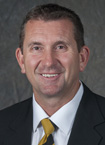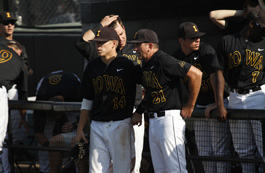Nov.
15, 2013
Meet
Iowa's Rick Heller
By Sean Ryan
CollegeBaseballInsider.com
Co-Founder
sean@collegebaseballinsider.com
@collbaseball
 Rick
Heller was in his 10th season leading Northern Iowa’s baseball
program when the school decided to drop the sport in 2009. That
jolt, he says, made him a better coach. Rick
Heller was in his 10th season leading Northern Iowa’s baseball
program when the school decided to drop the sport in 2009. That
jolt, he says, made him a better coach.
He landed softly when Indiana State named him
head coach after the 2009 season and guided the Sycamores to
four straight winning seasons, including their first outright
Missouri Valley Conference championship in school history in
2012. Indiana State went 41-19 that season, reaching the NCAA
tourney for the first time since 1995. Heller takes over at
Iowa, a program in search of its first NCAA appearance since
1990.
First Inning – What attracted you to Iowa, and
what made it a good fit for you at this point in your career?
Big Ten baseball has changed a lot in the last
five years. The RPI in the league is the highest it has been and
the league has received multiple bids to the NCAA tournament.
All of the programs in the league have made a commitment to win.
I believe this will continue.
With the addition of Rutgers and Maryland to an
already great league, the Big Ten will continue to get better
from top to bottom in baseball. The University of Iowa is the
only Division I program in our state. I feel we have an
opportunity to take the program to new heights. The
administration has made a commitment to improve our facilities
and give us the support we need to compete. I look at it as a
better chance to get to Omaha, and being a native Iowan and
coaching in the state for 24 years, it was a chance to go home.
Second Inning – How tough was it leaving Indiana
State, a program you took to the Regionals in 2012?
It was tough. I loved our players, and the
administration at Indiana State was outstanding to work for. I
was the happiest I had been in my career. We had great
facilities, support and the winning culture we had developed was
fantastic. The people in Terre Haute treated my family great, so
leaving was very difficult.
Third Inning – You’ve spent a lot of time in the
Missouri Valley Conference. How do you think the Big 10 is
similar or different to the MVC?
The Missouri Valley is a good baseball league.
With the addition of Dallas Baptist, it will only get better.
The Valley has some top-level players, facilities and great
coaches. For years, it seemed to me that a lot of
administrations in the Big Ten held programs back. The
facilities were lacking and money wasn’t being thrown baseball’s
way.
Having played many schools in the Big Ten the
last 14 years, I have witnessed a positive change in the last
three. Baseball is now being supported by most, if not all
schools in the league. That is all it ever needed to become a
power conference. The coaches in the league have always done a
great job; they just needed the resources to compete on the
national level.
With the success of the Big Ten Network, I only
see the support getting better. With Indiana going to the
College World Series and Purdue hosting an NCAA Regional two
years ago, I think most administrations can see that with
adequate support baseball can thrive in the Big Ten. One of the
main reasons I left Indiana State was the tremendous resources
that you have in the Big Ten.
 Fourth
Inning – Big 10 Baseball has seen an upswing in recent years.
What will it take for Iowa to excel in the Big 10? Fourth
Inning – Big 10 Baseball has seen an upswing in recent years.
What will it take for Iowa to excel in the Big 10?
It has already started. The commitment the
administration has made to me and my coaching staff is the first
step. Every coach has to have support to win at the national
level. We now have that. Our facilities have to improve. We are
currently installing AstroTurf on our infield, redoing our
backstop and dugouts. We will be getting a new indoor practice
facility that will be the size of a football field with new
cages next fall. The great thing about this facility is that
baseball and softball will have priority. We won’t have to share
with football. Next summer, we will finish the turf in the
outfield, add a new outfield fence and hopefully get a new
scoreboard with video capabilities.
In addition to facilities, we need to keep the
best Iowa players in state, while supplementing the Iowa talent
with players from across the country. I believe we can do this.
I’ve recruited nationally for years and have great connections
in all parts of the country. Being in the Big Ten will allow me
to recruit an even better student-athlete from out of state than
I have in the past.
Fifth Inning – This is your fourth head coaching
job. How have you changed over the years at each stop, and how
are you the same?
Being at some colleges that didn’t have much, I
appreciate the resources that we have at Iowa. Going through the
program being dropped at Northern Iowa gave me a new perspective
on baseball and life. I think I’m a better coach and person
after fighting through it. I love the player development side of
the game, and I think I’ve improved in this area at each stop.
I’ve been a grinder since Day 1, and I still am. The work ethic
and passion for the game are still the same.
Sixth Inning – You were born in Eldon, Iowa, a
town of less than 1,000. What do you remember about growing up
there? And how exciting is it to be coaching at a school so
close to where you were born?
Growing up in Eldon was great. We had a core
group of guys who played baseball every day in the summer on our
own. I had a lot of fun growing up in that small town and still
have a lot of close friends from home. Being close to my family,
friends and high school coaches has been great. I can’t tell you
how many people have already been up to visit this fall. I’ve
had calls and messages from so many people I hadn’t heard from
in years. It has been fantastic!
Seventh Inning – What was it like recruiting and
coaching a talent like Sean Manaea?
It was a lot of fun. When Sean was a freshman you
could see the potential, but he had a long way to go. Seeing him
work every day on his mechanics, in the weight room and in the
classroom was very rewarding. Sean’s story is a great one. We
all see kids with lots of potential that never get there. Sean
came farther than any player in my 30-year career, and he still
has more in the tank. His best years are ahead of him. Being a
player development guy, I really enjoyed his three years. It was
special.
Eighth Inning – You were a shortstop in college
and also played football and basketball. How tough was that in
college, and what do you miss about the sports you don’t coach?
I had a blast! It would be close to impossible
now, but in those days you could pull it off. The
football-to-basketball transition was the toughest. I usually
didn’t get to play much basketball until after Christmas.
Basketball-to-baseball was easier. You could get your baseball
work done in the mornings or after practice. I just loved to
play!
I was the receivers coach at Upper Iowa for 10
years, in addition to being the head baseball coach. Being
Division III, we were limited in what we could do in the fall in
baseball. I would leave football practice early on Thursday and
practice baseball until dark. We would do the same on Sunday
afternoons. I miss game day in football, but not all the film
study! The thing about football as a player is that when it’s
over, it’s over. You can’t play a full pad pick-up game. I
really missed it for a long time. My first full-time high
school job was in Bakersfield, Mo., where I was the head
basketball and baseball coach. I played enough “noon ball”
basketball when I was younger that I never missed it like you do
football.
Ninth Inning – If there’s one common denominator
you look for when recruiting players, what is it?
Most of the places I’ve coached were rebuilding
jobs. When we were recruiting, we weren’t getting the first pick
at recess, if you know what I mean. We had to find kids who
would overachieve and develop and be plus make up kids. I always
look for the most talented kid we can get with great make up and
toughness. These kids are usually humble. I’ve never had a kid
that overachieved that wasn’t humble. Those qualities are what
we look for first.
(photos courtesy of Iowa Media Relatons) |